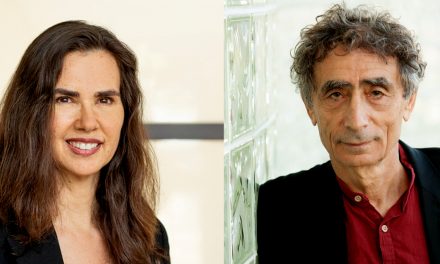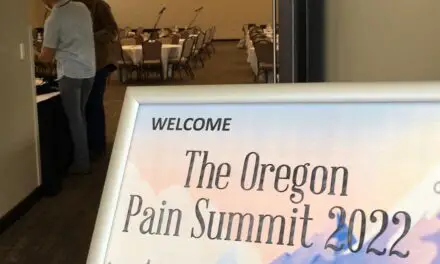It’s still too early for me to say whether my communication skills at work has improved or not after a week-long boot camp at the 2019 San Diego Pain Summit. Nearly all clients I had so far this week had some sort of chronic pain that nagged them. However, I had to bite my tongue many times when my clients shared their stories with me about their pain and current life before the session.
I kept thinking about physiotherapist Tim Beames’ patient’s story that he presented at one of the Pain Summit’s workshops last week regarding how we therapists tend to interject patients’ stories and explanations with our biases. While my tongue didn’t bleed from all that biting, it reminded me to listen and ask open-ended questions before I started the session.
There was something different about this year’s San Diego Pain Summit compared to previous Summits. It wasn’t just because about half of the attendants were first-timers. It wasn’t because it was cold enough to make some Canadians feel like they never left home. Kinda like this guy on the right.
I think it is how the workshops were arranged. The first two workshops leaned more toward the “bio” side of the biopsychosocial framework of pain with physiotherapist Adam Meakins covering shoulder rehab, physiotherapist Erik Meira covering knee rehab, and Dr. Tim Beames covering the philosophical and biological aspects about pain.
The last two workshops leaned toward the “psychosocial” side with Ben Cormack’s behavior in movement relating to the lower back and lower limbs and improv patient communication with Dr. Sandy Hilton, Mike Stewart, Keith Waldron, and Alison Sim.
Rajam Roose, the founder of this one-of-a-kind event, placed the workshops and the speakers of the main event like a role-playing game, laying out the setting, connecting the plots, and allowing the participants and the presenters to “play out” the act. For many therapists and other clinicians who are new to applied BPS framework of healthcare, they are like the level 1 to 5 fighter, wizard, or cleric in a Dungeons & Dragons game. And for many like myself, we fall somewhere between level 6 and 20.

Beyond Tissues and Techniques
Keynote speaker Dr. Antonio Damasio, who is a professor of neurology, psychology, and philosophy at the University of Southern California, explored pain with connections to homeostasis and consciousness. The topic itself goes over my head, but the gist of the talk is that the pain experience is more than just the nervous system and the brain (although they still play a HUGE role in the pain experience). To me, there are gaps in understanding such experience that I am still trying to nail down like pin-pointing a pattern in a foreign language. Well, this is not the first time I had experienced such confusion. When placebo researcher Dr. Fabrizio Benedetti presented at the 2016 SDPS, it took me almost a whole year to wrap my head about placebo’s role in medical treatment and about how our expectations and perception shape a treatment’s outcome. Perhaps with Damasio’s talk, it would be about the same experience.
The rest of the presentation focused a lot about therapeutic relationships, including language, expectations and placebo/nocebo, listening and validation, and patients’ pain experience. I thought I was going to drift off like a leaf in the wind (I was out of coffee) at the last speaker of Day One, Dr. Karen Davis, who presented bridging research with practice. That woman hoards a GOLD MINE of research that examines brain imaging in relation to the legal and justice system in the U.S.
Another rabbit hole.
Oh, and “just Google me,” she says.

Day Two stored a little surprise for me as well as for many people. Physiotherapist Keith Waldron’s “In Pursuit of a Premise,” a letter to another physiotherapist Barrett Dorko, who had influenced who Waldron think about what he does and thinks .
A few thought it was tedious and too long. They did not connect with the message as well as those who did, but that is perfectly fine with me when I heard their stories. For some who connected with the letter to Barrett Dorko, it meant something not only in their practice, but also in their personal lives—with their children, parents, partner or spouse, or their community.
This passage from Dr. Rachel Naomi Remen that Waldron recited resonated with me the most:
“Serving is different from helping. Helping is based on inequality; it is not a relationship between equals. When you help you use your own strength to help those of lesser strength. If I’m attentive to what is going on inside of me when I’m helping, I find that I’m always helping someone who is not as strong as I am, who is needier than I am.
“People feel this inequality. When we help we may inadvertently take away from people more than we could ever give them; we may diminish their self-esteem, their sense of worth, integrity and wholeness. When I help I am very aware of my own strength. But we don’t serve with our strength, we serve with ourselves. We draw from all of our experiences.
“Our limitations serve, our wounds serve, even our darkness can serve. The wholeness in us serves the wholeness in others and the wholeness in life. The wholeness in you is the same as the wholeness in me. Service is a relationship between equals.” ~ Rachel N. Remen
The entire letter is right here: Letter to Barrett Dorko.
Taking a break between presentations. Photo: Nick Ng

Although the San Diego Pain Summit is targeted toward physiotherapists, many massage therapists attended the entire event, workshops only, or just the weekend event. Rajam told me that 30-35% of this year’s attendees were fellow massage therapists, including 13 RMTs from Canada, 21 American therapists, two from New Zealand, one from Ontario, Canada, and one from Austria. Seems like Americans finally outnumbered Canadians this year.
There were also two chiropractors from Victoria, BC, one psychologist, one MD, two occupational therapists, and three personal trainers from Denmark.
“It was encouraging to see so many massage therapists at the Summit,” ~ Jamie Johnston, RMT
To my delight, there were at least 10 DPT students from the University of St. Augustine in San Marcos, California, who attended the weekend event.

I have attended many fitness summits and events since 2002 and a few massage therapy and pain research conferences since 2015, and I have never experienced such strong connection and laughter in the past. I think it may be so because Rajam’s “progeny” is focused on bridging research and critical thinking with hands-on practice, developing a better patient-centered environment and serving the public better. People who attended the Summit and the workshops are truly interested in applied science and instigate better changes in our profession and the public. Unlike most conferences I had attended, there are almost no salespeople trying to sell others their stuff at the San Diego Pain Summit. The value is among the people.
No government, corporation, or national organization is going to make such important changes; those changes start from the ground up.
As Rachel Ah Kit said, “I think the hugging at [San Diego Pain Summit] is representative of attendees’ connection with other humans. We are presented with scientific evidence, evaluate it, then figure out how to use that in our own clinical settings with care and compassion towards the people we work with.”
See you next year at #sdpain2020!
And registration for 2020 is open!
“Society grows strong when old therapists plant trees under whose shade they know that they will never sit.” ~ Phil Greenfield

A native of San Diego for nearly 40 years, Nick Ng is an editor of Massage & Fitness Magazine, an online publication for manual therapists and the public who want to explore the science behind touch, pain, and exercise, and how to apply that in their hands-on practice or daily lives.
An alumni from San Diego State University with a B.A. in Graphic Communications, Nick also completed his massage therapy training at International Professional School of Bodywork in San Diego in 2014.
When he is not writing or reading, you would likely find him weightlifting at the gym, salsa dancing, or exploring new areas to walk and eat around Southern California.






